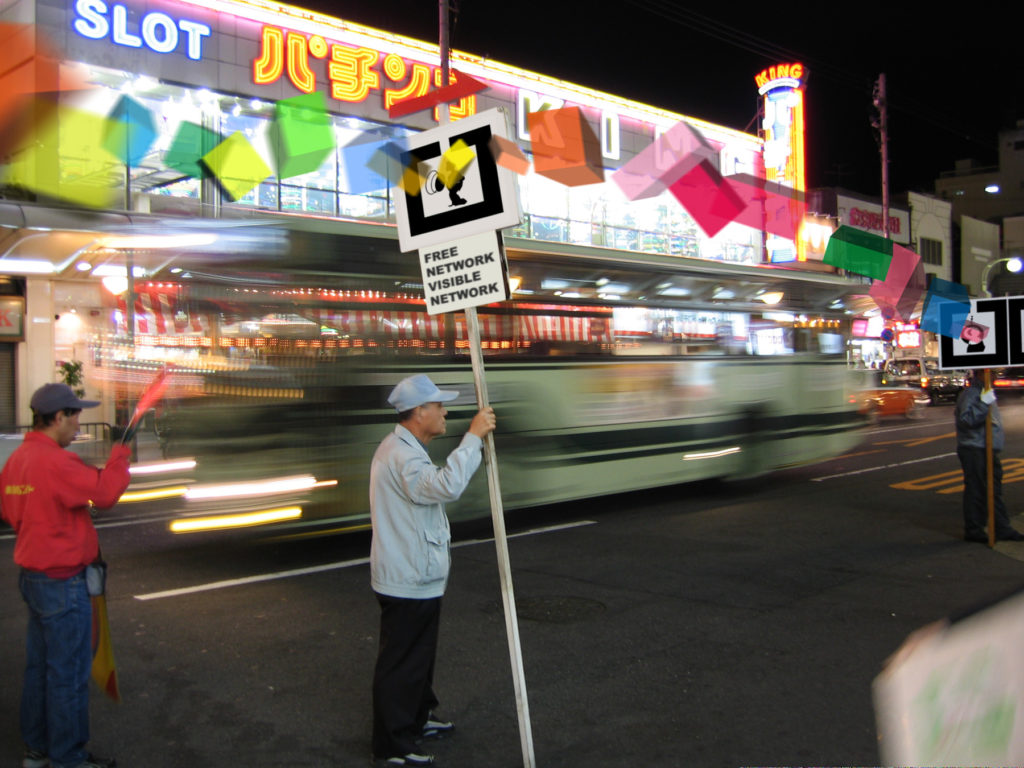Free Network Visible Network

MXRToolkit and CarnivorePE
2004
Free Network Visible Network combines different tools and processes to visualize by means of augmented reality techniques, floating in space, the flow of information exchanged by users of a network. Users can observe the colourful virtual objects that represent digital data flying through real space. These objects have different shapes, sizes and colours in relation to the characteristics of the information that circulates through the network.
In the last twenty years, digital information has flooded the world in which we live. No matter where we are, even if we are unable to see it, we can imagine how we are surrounded by data. These data, despite their digital nature, are communicating to people, are full of information that contains knowledge, ideas, feelings and emotions. The space of digital networks is also the space of invisible meanings that represent relationships between people and a dynamic exchange of knowledge. But unfortunately, not everyone can access this information because of technical, economic or even political limitations. Most digital networks are restricted and information is often filtered in relation to economic or ideological criteria that affect the final recipient.
With the metaphorical representation of these invisible meanings, this project wants to act in the urban space as a way to create new strategies in the public space and demand, through artistic actions, the freedom and the right of citizens to access and control the digital space of communication.
This project takes place at the same time in the physical and digital public space, establishing direct relationships between visual messages, physically placed in the city, streets and digital information floating in the air. The real messages and the virtual information are connected by the main element of this project: the Visible Network software that converts the captured data of a network into virtual objects and superimposes them in real-time to real space. This software is mainly based on augmented reality technology using MXRToolKit, an open-source tool, developed in the Mixed Reality Lab of the National University of Singapore, combined with CarnivorePE, a software-art project of the Radical Software Group that listens to traffic Internet of a specific network. The union between these technologies has allowed us to develop this system to visualize in augmented reality the metaphorical representation of the data that continuously surrounds us.
Free Network Visible Network combina diferentes herramientas y procesos para visualizar por medio de técnicas de realidad aumentada, flotando en el espacio, el flujo de información que intercambian los usuarios de una red. Los usuarios pueden observar los objetos virtuales de colores que representan los datos digitales volando por el espacio real. Estos objetos tienen formas, tamaños y colores diferentes en relación a las características de la información que circula por la red.
En los últimos veinte años la información digital ha inundado el mundo en el que vivimos. No importa donde estemos, incluso si no somos capaces de verlo, nos podemos imaginar como estamos rodeados de datos. Estos datos, a pesar de su naturaleza digital, están comunicando a personas, están llenos de información que contiene conocimiento, ideas, sentimientos y emociones. El espacio de las redes digitales también es el espacio de los significados invisibles que representan relaciones entre personas y un intercambio dinámico de conocimiento. Pero desafortunadamente no todo el mundo puede acceder a esta información a causa de limitaciones técnicas, económicas o incluso políticas. La mayor parte de las redes digitales están restringidas y a menudo la información es filtrada en relación a criterios económicos o ideológicos que afectan al receptor final.
Con la representación metafórica de estos significados invisibles, este proyecto quiere actuar en el espacio urbano como manera de crear nuevas estrategias en el espacio público y reclamar, por medio de acciones artísticas, la libertad y el derecho de los ciudadanos a acceder y controlar el espacio digital de comunicación para crear Redes Libres que ofrezcan acceso a la información abierta y libre a todo el mundo.
Este proyecto tiene lugar al mismo tiempo en el espacio público físico y el digital, estableciendo relaciones directas entre mensajes visuales, físicamente colocados en las calles de la ciudad y información digital que flota en el aire. Los mensajes reales y la información virtual están conectados por el elemento principal de este proyecto: el software Red Visible que convierte los datos capturados de una red en objetos virtuales y los superpone en tiempo real al espacio real. Este software está basado principalmente en la tecnología de realidad aumentada usando MXRToolKit, una herramienta open source, desarrollada en el Mixed Reality Lab de la National University de Singapur, combinado con CarnivorePE, un proyecto de software-art del Radical Software Group que escucha el trafico de internet de una red específica. La unión entre estas tecnologías nos ha permitido desarrollar este sistema para visualizar en realidad aumentada la representación metafórica de los datos que continuamente nos rodean.